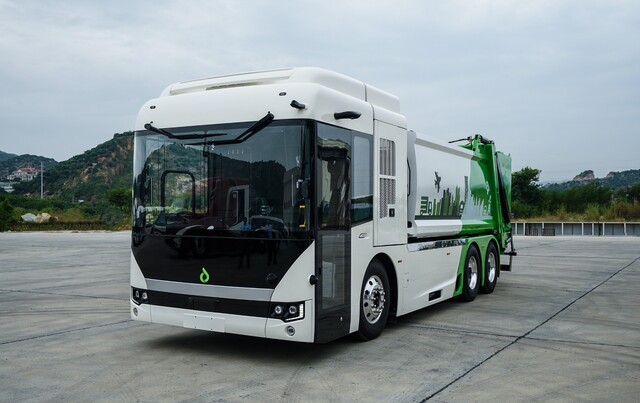by Cam Lucadou-Wells
A quiet, zero-emission garbage truck powered by hydrogen was being pitched to councils, truck companies and waste operators in Dandenong South on 1 May.
Greater Dandenong mayor Lana Formoso was among the guests getting behind the wheel of the hydrogen fuel cell (HFC) powered truck at manufacturer Hendrickson – which makes component parts for the vehicle.
“The hydrogen garbage truck will play an important role in reducing carbon emissions,” she said.
“I look forward to seeing zero-emissions trucks on our roads.
“I’m proud that Dandenong South is the home of such innovations. Our manufacturing hub is a major national player in manufacturing innovation and the hydrogen truck is just one example.”
Touted as an Australian first, the big green truck is being trialed by Solo Resource & Recovery on the Gold Coast.
The proponent Pure Hydrogen has earmarked Dandenong for perhaps manufacturing the truck as well as being one of its main hydrogen-refuelling stations.
Initially, the stations in Dandenong, Geelong and Port of Melbourne are expected to each produce 420 kilograms of hydrogen a day through solar and green electricity.
It would be enough to refuel about 20 trucks a day at each station.
By 2026, production is expected to rise to 1000 kilograms each a day.
Dandenong is also seen as a possible site to manufacture fleets of Pure Hydrogen buses and prime movers for domestic and export markets, as well as generators, electolysers and refuellers.
Pure Hydrogen national sales manager Clint Butler said currently the Australian-designed vehicles are being assembled in China.
“We’re hoping in two or three years to have a factory in Queensland, NSW and Victoria – and Dandenong is one of the ones earmarked for Victoria.”
Recently, Casey Council announced its partnership with Cleanaway to trial a low-emission garbage truck running on converted cooking oils.
Councils, enthusiastic to reduce emissions, will start to force waste collection contractors to go hydrogen, Butler predicts.
“We field enquiries from councils from across Australia every day. As we have the trucks on the road, it will open the floodgates.”
Butler says a dampener is the lack of government subsidies for hydrogen vehicles. In contrast, the US offers 80 per cent subsidies.
Another hand-brake is the lack of infrastructure, such as access to hydrogen fuel.
Pure Hydrogen is proposing ‘hydrogen highways’ of micro-hubs along Hume Highway, Western Highway and the Princes Freeway between Melbourne and Geelong.
These would refuel vehicles such as its Taurus prime mover, which has a range of 400 kilometres.
It also proposes mobile refuelers that will visit truck depots in Dandenong.
The technology has moved on from the Hindenburg airship disaster in 1937.
“Not a day goes by without hearing about the Hindenburg. Do you know since then we’ve put a man on the moon using hydrogen? And the International Space Station uses hydrogen to provide fresh water for its astronauts?
“Since the Hindenburg, we don’t put hydrogen in a canvas balloon. We store it in a type-4 carbon cylinder which is the strongest part of the truck.”
Waste trucks often catch fire due to batteries being ill-advisedly disposed in household rubbish.
In such situations, the truck can expel its hydrogen load into the air within minutes – whereas diesel fuel gravitates under the truck.









